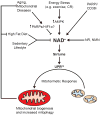NAD(+) Metabolism and the Control of Energy Homeostasis: A Balancing Act between Mitochondria and the Nucleus
- PMID: 26118927
- PMCID: PMC4487780
- DOI: 10.1016/j.cmet.2015.05.023
NAD(+) Metabolism and the Control of Energy Homeostasis: A Balancing Act between Mitochondria and the Nucleus
Abstract
NAD(+) has emerged as a vital cofactor that can rewire metabolism, activate sirtuins, and maintain mitochondrial fitness through mechanisms such as the mitochondrial unfolded protein response. This improved understanding of NAD(+) metabolism revived interest in NAD(+)-boosting strategies to manage a wide spectrum of diseases, ranging from diabetes to cancer. In this review, we summarize how NAD(+) metabolism links energy status with adaptive cellular and organismal responses and how this knowledge can be therapeutically exploited.
Copyright © 2015 Elsevier Inc. All rights reserved.
Figures




References
-
- Aksoy P, Escande C, White TA, Thompson M, Soares S, Benech JC, Chini EN. Regulation of SIRT 1 mediated NAD dependent deacetylation: a novel role for the multifunctional enzyme CD38. Biochemical and biophysical research communications. 2006a;349:353–359. - PubMed
-
- Aksoy P, White TA, Thompson M, Chini EN. Regulation of intracellular levels of NAD: a novel role for CD38. Biochemical and biophysical research communications. 2006b;345:1386–1392. - PubMed
-
- Aksoy S, Szumlanski CL, Weinshilboum RM. Human liver nicotinamide N-methyltransferase cDNA cloning, expression, and biochemical characterization. The Journal of biological chemistry. 1994;269:14835–14840. - PubMed
-
- Alano CC, Tran A, Tao R, Ying W, Karliner JS, Swanson RA. Differences among cell types in NAD(+) compartmentalization: a comparison of neurons, astrocytes, and cardiac myocytes. Journal of neuroscience research. 2007;85:3378–3385. - PubMed
Publication types
MeSH terms
Substances
Grants and funding
LinkOut - more resources
Full Text Sources
Other Literature Sources
Molecular Biology Databases

